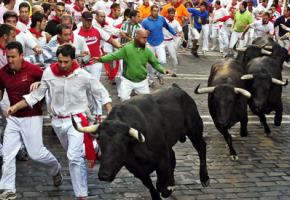The city that never sleeps
With a population of 3.3million, Madrid is roughly half the size of London. But rarely do you hear London referred to as‘la ciudad que nunca duerme.’ This epithet belongs to Madrid, and is testament to a tapas-and-nightlife culture to rival no other. For excellent tapas from not just theComunidad de Madrid but all over Spain, try the La Latinaarea of the city centre on a Sunday. The Cava Baja road brims over with young people celebrating the weekend, and the lively atmosphere is the perfect prelude to a night out in one of the city’s many bars and clubs.
International holidaymakers tend to prefer the larger, commercial clubs such as Joy or Kapital, but if you have perhaps a little longer to appreciate the city (and are unwilling to splurge 20€ on the larger clubs’ entry fee!), the Malasañaarea is fast becoming the go-to barrio for alternative entertainment, both night and day, with smaller venues such asEl Nasti and Tupperware providing sometimes kitsch, but always fun entertainment. Daytime venues offering original, relaxing settings include the Marion café in the studentyArgüelles barrio, and ‘Living in London,’ a British-inspired tea shop on the Santa Engracia road.

Arts and culture
Despite its capital city status, Madrid has a reputation amongst more-seasoned travellers as a city where tourists and locals mix freely, in counterpoint to the southern costas, or even magical Barcelona. However, when you do want to seek out the typical tourist hotspots, don’t miss the so-called Golden Triangle of Art, comprising the Prado museum, the Reina Sofía and the private Thyssen galleries, located around the stunningly green Retiro park area. Great Spanish masters like Goya, Velázquez and Picasso hang alongside visiting collections, which have recently included the likes of Renoir, and present-day photography by Mario Testino. For hardcore art aficionados, Madrid’s smaller galleries are also worth a visit – the Museo Sorolla in Chamberí is one example of many, as is CaixaForum – an initative supported by laCaixa bank bringing culture to the public for free.
Market mania
However, if art isn’t your thing, then you might well wish to sample some of Madrid’s eclectic markets. The most famous of these is the Rastro street market, held on a Sunday morning inLa Latina, where stalls range from the more conventional clothing and accessories to the downright bizarre – rusty old keys anyone? Try and get there as it opens, around 10am, before the narrow streets become too crowded. If you don’t want to get up too early, Mercado San Miguel near the Plaza Mayor is always an interesting experience. This market specialises in food, to be eaten at the bustling bars within the market building itself, or to take-away and enjoy later. Top tips would definitely have to be the delectable frozen yoghurt stall, and the neighbouring bollería. In addition to these permanent markets, watch out for the many pop-up stalls and fairs which appear in the city at various times of year. The October book fair by the national library is not to be missed, and neither is the Christmas market in and around the Plaza Mayor. This year the set-up is comprised of 82 stalls selling a variety of unique gifts, and is illuminated from above with a beautiful light display.

Heritage
Having said that there is no picture-postcard moment to sum up life in Madrid, the city still boasts many, if lesser-known internationally, impressive sights. The Puerta de Alcalá is reminiscent of Berlin’s Brandenburg Gate, and the Royal Palace’s guided tour is worth a try, at 10€ for the inside scoop on its grandeur. Less traditionally, Madrid’s Gran Vía, is one of the city’s main shopping and leisure streets, and also not to be missed are the local fiestas, especially the fiesta of San Isidro, Madrid’s patron saint, on the 15th of May. Festivities include special bullfights, held at the plaza de toros at Las Ventas, throughout the fiesta.
Getting there
Madrid is easily accessible from the UK by air, with flights operated by Easyjet, Ryanair, Iberia and British Airways usually readily available and affordable. Check outwww.skyscanner.net for route maps and prices.
Once in Madrid, the easiest way to get around is usually by the extensive metro network Tourist passes covering Zone A (the city centre) cost less than 18€ for 5 days unlimited travel, and also cover most bus and suburban train (cercanías) services.
For more information, try the municipal website atwww.madrid.es, and for slightly younger visitors,www.madrid.org/inforjoven . The Guía del Ocio, a weekly magazine advertising the Madrid social scene in detail, is available at city estancos (tobacconists) priced at 1€.



















